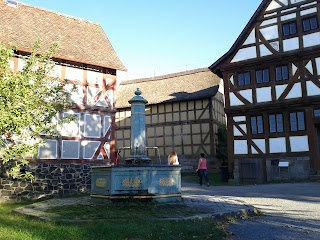ok...so I may be a little overexcited about that!!! But I love public transportation! and I love that I can live in Darmstadt without a car! And I love that I get to take public transportation to work.
Well...anway...Hi Everyone,
Now that I have shared my complete obsession with public transportation, it is time to turn our attention to the important subject of my blog post. What exactly is it that I have been offered this Fulbright scholarship to do? I know that many of you have asked my mom about my project and I know that she has tried to explain it from details gathered from my numerous descriptions. However, as she told me a few days ago, she doesn't really understand it. So here I go, trying my best to untangle the confusion.
I work at GSI Helmholtzzentrum für Schwerionenforschung (in English that is GSI Helmholtz Center for Heavy Ion Research -- don't you like how in English that name is six words, but in German it is only three?).
The above picture is a birds eye view of the GSI facility. The big white buildings at the far right are the warehouse like buildings where all of the experimental equipment is built and contained. GSI is internationally known for their work with heavy ions. The six elements with atomic numbers 107-112 -- Bohrium, Hassium, Meitnerium, Darmstadtium, Roentgenium, and Copernicium -- were discovered at GSI. The technique to use heavy ion radiation to treat brain cancer was also invented at GSI. Several hundred patients were treated at GSI, before a bigger treatment facility was built in Heidelberg. So all in all, GSI is a pretty important place!!
However, I am working in none of the above projects! I am working in the HITRAP group. We are in the middle of building a beamline (which is the name given to a large devise that transports ions, atoms, or particles of other kinds, from one place to another) which will slow down heavy, highly charged Ions until they are at rest or nearly at rest. Heavy ions actually refers to any ion that is heavier than Helium; however, the goal for the HITRAP experiment is to be able to work with Uranium + 92 (that is a U atom with all of its electrons taken off!!) Below is a schematic that shows how my project works. Don't worry, I will explain it in great detail!
Before I get into the specifics of how my group is achieving this, let me explain how the GSI facility makes these heavy, highly charged ions. The UNILAC is a linear accelerator and accelerates heavy atoms to 20 percent of the speed of light. SIS is a heavy ion sychrotron that further accelerates the atoms to 90 percent the speed of light! WOWZERS! Then the ions are sent through a stripping foil, where all of their electrons are taken off. Now we are in business! We have our heavy, highly charged ions. They are then sent to the experimental storage ring, ESR, where they are slowed down a little, but more importantly stored until they are needed. The UNILAC, SIS, and ESR are permanent facilties at GSI. They are used for many experiments.
For the HITRAP experiment the ESR spits out our ions into a linear decelerator. Here the ions are decelerated from 4 MeV/u to 6keV/u. For those of you who don't know eV is short hand for an electron volt. An electron volt is a measure of energy. One electron volt is the amount of energy an electron gains when accelerated through a potential difference of 1 volt. In physics we tend to refer interchangeably to energy and speed. Anyway if that was confusing let me generally say that the linear decelerator (part of which is pictured below) slows down the ions a lot!
Then comes my part. I have to commission the beamline that transports these ions from the linear decelerator to the penning cooler trap. The ions are further slowed down in the penning cooler trap. The problem is that the penning cooler trap is on a platform about 3 meters above the linear decelerator. So my beamline, called the vertical beamline, has to transport these ions up about 9 feet! The majority of this beamline has been built. However there is a lot to do. To turn the ions around corner, there are various elements in the beamline that can produce electric and/or magnetic fields to influence the ions. Since no one has ever seen how these elements work, I am currently simulating the entire beamline in a computer program. Later when I have an idea of the electric and magnetic fields needed at each point in the beamline, I will begin to perform tests of transporting the beamline.
The end! I hope you know have a little better understanding of what exactly my project is about. I promise that my next post will have a lot more pictures!
love,
Lizzie


























































